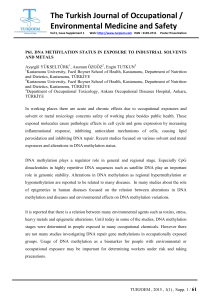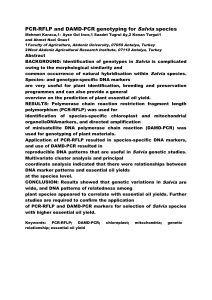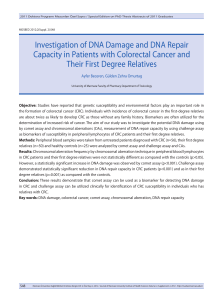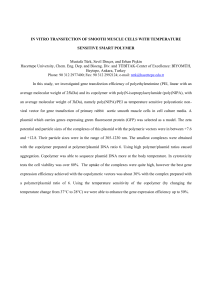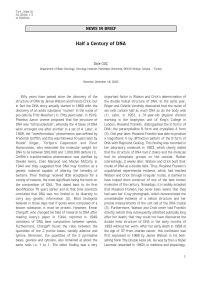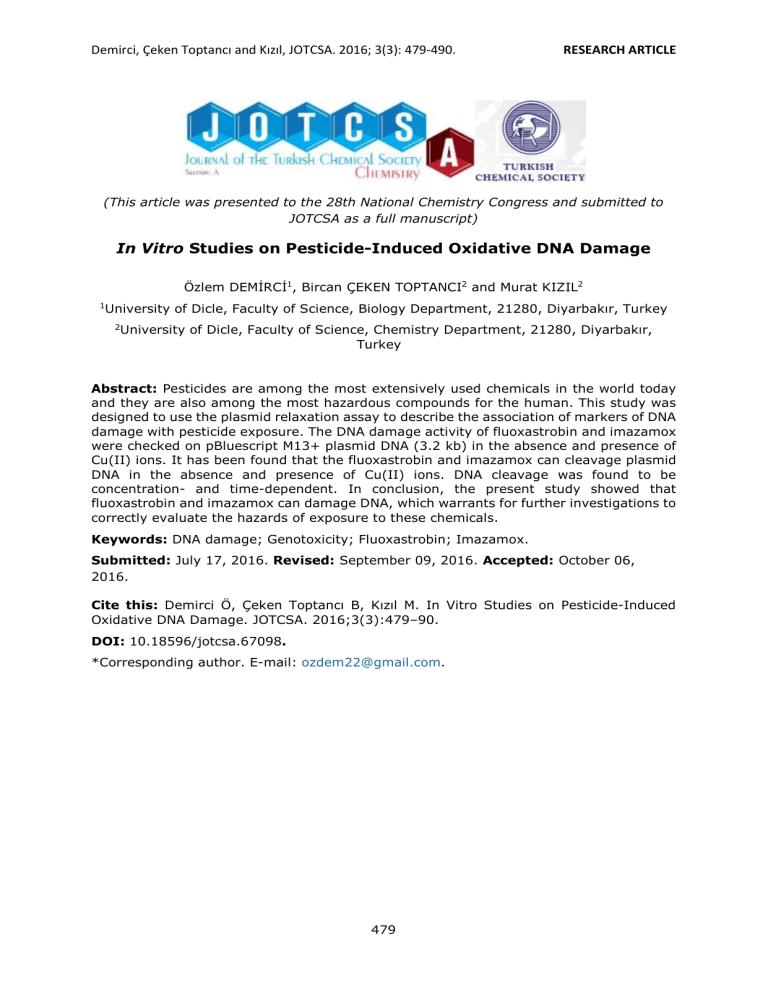
Demirci, Çeken Toptancı and Kızıl, JOTCSA. 2016; 3(3): 479-490.
RESEARCH ARTICLE
(This article was presented to the 28th National Chemistry Congress and submitted to
JOTCSA as a full manuscript)
In Vitro Studies on Pesticide-Induced Oxidative DNA Damage
Özlem DEMİRCİ1, Bircan ÇEKEN TOPTANCI2 and Murat KIZIL2
1
University of Dicle, Faculty of Science, Biology Department, 21280, Diyarbakır, Turkey
2
University of Dicle, Faculty of Science, Chemistry Department, 21280, Diyarbakır,
Turkey
Abstract: Pesticides are among the most extensively used chemicals in the world today
and they are also among the most hazardous compounds for the human. This study was
designed to use the plasmid relaxation assay to describe the association of markers of DNA
damage with pesticide exposure. The DNA damage activity of fluoxastrobin and imazamox
were checked on pBluescript M13+ plasmid DNA (3.2 kb) in the absence and presence of
Cu(II) ions. It has been found that the fluoxastrobin and imazamox can cleavage plasmid
DNA in the absence and presence of Cu(II) ions. DNA cleavage was found to be
concentration- and time-dependent. In conclusion, the present study showed that
fluoxastrobin and imazamox can damage DNA, which warrants for further investigations to
correctly evaluate the hazards of exposure to these chemicals.
Keywords: DNA damage; Genotoxicity; Fluoxastrobin; Imazamox.
Submitted: July 17, 2016. Revised: September 09, 2016. Accepted: October 06,
2016.
Cite this: Demirci Ö, Çeken Toptancı B, Kızıl M. In Vitro Studies on Pesticide-Induced
Oxidative DNA Damage. JOTCSA. 2016;3(3):479–90.
DOI: 10.18596/jotcsa.67098.
*Corresponding author. E-mail: ozdem22@gmail.com.
479
Demirci, Çeken Toptancı and Kızıl, JOTCSA. 2016; 3(3): 479-490.
RESEARCH ARTICLE
INTRODUCTION
Though extreme anthropogenic activities bring about innumerable accumulation of
xenobiotics in biosphere (1, 2), especially pesticides are designed specifically to kill the
organisms. Therefore, they are one of the most dangerous chemical compounds (3).
Pesticides have to comply with a demand: a high degree of toxicity for only target
organisms, but synthetic pesticides are quite inadequate in this respect (4). Pesticides
consist of a heterogeneous class of chemicals, developed for the purpose of controlling
pests, requisite in modern agriculture, but numerous studies available in the literature are
with regard to their genotoxicity (5).
The primary risk factor is the genotoxic potential for long-term effects such as carcinogenic
and reproductive toxicology. Most of the pesticides have been tried in a wide range of
mutagenicity assays covering gene mutation, DNA damage and chromosomal alteration
(6).
Fluoxastrobin is a new strobilurin-type fungicide and it has a broad spectrum of activity
against many fungal diseases. It is known that Fluoxastrobin has been registered for foliar
utilization on corn vegetables, peanuts, and tuberous, fruiting vegetables, leaf petiole
vegetables, and turf, as well as peanut.
Imazamox is a widely used herbicide in the imidazolinone herbicide family and inhibits the
acetolactate synthase enzyme, which is critical for the synthesis of the amino acids valine,
leucine, and isoleucine in plants.
In field crops, imazamox is effective against a large variety of grass and broadleaf weeds,
including downy brome, red rice, shattercanech, jointed goatgrass, wild mustards, common
ragweed, common lambsquarters, and others. Pesticides tend to accumulate in the
environment and organisms.
It was reported that the amount of pesticide utilized was approximately 2.4 million tons in
both 2006 and 2007, with herbicides calculating for the largest part of the total use,
followed by other pesticides, fungicides, and insecticides (7). Distinct agriculture
applications practised in agricultural areas of the extensive farming inside of hothouses
(most especially close the seaboard) and another hand conventional agriculture, which
accounts for a heterogeneous type of pesticide use (8).
480
Demirci, Çeken Toptancı and Kızıl, JOTCSA. 2016; 3(3): 479-490.
RESEARCH ARTICLE
Pesticides can be connected to each groove of the DNA double helix with various noncovalent interactions. For example; pesticides can be linked in the wall/surface of each
groove of DNA with hydrophobic interaction, specific hydrogen bonds or van der Waals
interactions.
Experimental input demonstrated that numerous pesticides had mutagenic qualities
causing genetical chromosomal alteration, DNA damage, or mutation (9).
Pesticides
exposure
caused
increasing
incidence
of
cancer,
endocrine
disorders,
neurodegenerative disorders, birth defects, reproductive disorders, Parkinson, Alzheimer,
diabetes, cardiovascular diseases, chronic nephropathies, and chronic respiratory disease
(10).
However, few in vitro studies focusing on effects of pesticides on DNA damage have been
performed. A study of the genotoxicity of chemicals, such as fluoxastrobin and imazamox
is important because of their possible consequences on human health and their relation
with cancer and other diseases. Therefore, the aim of present study was to determine the
effect of fluoxastrobin and imazamox on plasmid DNA in the absence and presence of ions
Cu(II) ions.
MATERIALS AND METHODS
Chemicals
Fluoxastrobin, Imazamox, acetone, agarose, bromophenol blue, copper(II) chloride,
sodium chloride, ethylenediaminetetraacetic acid (EDTA), glacial acetic acid, and trisma
base were purchased from Sigma-Aldrich (St Louis, MO) and ethidium bromide was
obtained from Amresco LLC (Solon, OH). Plasmid miniprep kit was obtained from Qiagene
(Valencia, CA).
Purification of Plasmid DNA
Genejet plasmid mini preparation kit was used to isolate the pBluescript M13+ plasmid
DNA. U.V spectroscopy was used to checked the purity of plasmid DNA. DNA concentration
is estimated by measuring the absorbance at 260 nm. (A260 = 1.0 for 50 µg/mL).
481
Demirci, Çeken Toptancı and Kızıl, JOTCSA. 2016; 3(3): 479-490.
RESEARCH ARTICLE
DNA Damage with Fluoxastrobin and Imazamox
This study was designed to use the plasmid relaxation assay to describe the association of
markers of DNA damage with pesticide exposure (11). DNA cleavege activity of
fluoxastrobin and imazamox were checked in the absence and presence of Cu(II) ions on
pBluescript M13+ plasmid DNA (3.2 kb) by agarose gel electrophoresis according to Çeken
(12).
0.5-mL Eppendorf tubes which were covered with aluminum foil were used for the reactions
and for protecting the samples from light. All reactions were performed in a volume of 10
µL, containing 200 ng of pBluescript M13+ plasmid DNA at room temperature, in phosphate
buffer (pH 7.4; 14.29 mM NaCl, 7.14 mM phosphate). Fluoxastrobin and Imazamox (50,
100, 150, 200, 250 μg/mL) were added in the absence and presence of (II) at a final
concentration of 100 µΜ. Electrophoresis was performed in the presence of ethidium
bromide (10 mg/mL), at 60 V for 90 minutes.
In this experiment, we take advantage of the fact that double-stranded plasmid DNA
molecules generally exhibit three conformations that reflect the integrity of the DNA:
Supercoiled (sc), open circular (oc), and linear (l).
Densitometric analysis
Gel documentation system was used for scanning to the gel (Gel-Doc-XR; BioRad).
RESULTS AND DISCUSSION
In order to assess whether prolonged exposure to pesticides in the presence of metal ions
could lead to an increase in genetic damage, plasmid DNA exposed to pesticides were
evaluated using plasmid relaxation assay.
Excessive use of pesticides in agricultural or domestic areas results in environmental
contamination. Though pesticides have significant contributions for the elimination of the
harmful effects of pests on plant, animal, and human, they have toxic effects on the nontarget organism.
482
Demirci, Çeken Toptancı and Kızıl, JOTCSA. 2016; 3(3): 479-490.
RESEARCH ARTICLE
It has been clearly demonstrated that pesticidal toxicity alters a variety of physiological
functions. Additionally, evidence has shown that pesticide exposure can promote the risk
of neurodegenerative diseases and cancer.
Recent evidence also suggests that the pesticides which act as endocrine disruptors have
the ability to cause diverse side effect regarded to developmental toxicity and reproductive.
Therefore, it is now evident that research towards understanding how pesticides effect the
progression and development of disease will cause to further improvements in public
health.
In the literature, chlorpyrifos, methyl parathion, and malathion were investigated for their
DNA damage activities (13, 14). However, there is no study with new generation pesticides.
Therefore, in this study we used the plasmid relaxation assay to describe the association
of markers of DNA damage with fluoxastrobin and imazamox exposure. Plasmid relaxation
assay is a cheap and fast method to explain the toxic effect of pesticide. Oxidative damage
to DNA is one of the most important mechanisms in the initiation of cancer such damage
is sometimes caused by pesticides.
This study is the first to investigate the role of metal ion (copper) in the observed toxic
action of pesticides. It is known that copper has the ability to capable of mediating the
action of several phenolic compounds producing reactive oxygen and other radicals (15).
Since copper exists in the nucleus and is closely associated with chromosomes and DNA
bases, in this study we have investigated whether the activation of pesticides such as
fluoxastrobin and imazamox by copper can induce strand breaks in DNA. Copper salts have
been used extensively as fungicides for a long time so that it is very important to
investigate the effects of the combination of copper with other pesticides (16).
The role of fluoxastrobin and imazamox DNA damage was evaluated, and the exposure
time is presented in Figure 1-4. As shown in Figures 1 and 3, fluoxastrobin at
concentrations between 50-250 µg/mL has no significant effect on cleavage of plasmid
DNA in the absence and presence of Cu(II) ions (Figure 1, lane 2-6; Fig 3, lane 3-7). On
the other hand, at the concentration between 50-250 µg/mL imazamox can effectively
promote cleavage of plasmid DNA in the absence and presence of Cu(II) ions (Figure 2,
lane 2-6; Fig 4, lane 3-7).
483
Demirci, Çeken Toptancı and Kızıl, JOTCSA. 2016; 3(3): 479-490.
RESEARCH ARTICLE
In the presence of 100 µM concentration of Cu(II), imazamox (50-250 µg/mL) induced
extensive DNA strand breaks as indicated by disappearance of supercoiled (sc) form and
the formation of open circular (oc) and linear form (l).
Copper is widely distributed in nature and is an essential element. Acute poisoning occurs
most frequently from the ingestion of copper sulfate or other copper salts, and hepatic
necrosis is characteristic of copper poisoning. The redox properties of copper and iron
complexes of adriamycin, bleomycin, and thiosemicarbazones have been investigated by
electron spin resonance spectroscopy (ESR) (17).
A common property of these metal complexes is their ability to be readily reduced by thiol
compounds and oxidized by iron or reduced species of iron to produce free radicals. Copper
is also a common cofactor for many enzymes including oxidases and oxygenases (18).
Similar to iron, copper acts as a catalyst in the formation of reactive oxygen species and
catalyzes peroxidation of membrane lipids (19). The metal ions present in some pesticides
and fertilizers (20) may interfere with DNA repair and produce reactive oxygen species
(ROS), leading to oxidative damage (6). The pesticide-metal ion-DNA associations might
contribute to genotoxicity.
The individual and the combined toxicity of pesticides and metals were studied by
Bhuvaneshwari et al. (2012). They observed that pesticides, metal ions, and a mixture of
them caused DNA damage and this damage inducts mutation in the GADD45β gene (21).
The cleavage of DNA was found to depend on both the concentration of pesticide and the
reaction time (24-48 h). Our results indicate that both pesticides used in this study have
the ability to damage plasmid DNA in the absence and the presence of metal ions.
Therefore, further detailed evaluation of genotoxicity is thus required.
484
Demirci, Çeken Toptancı and Kızıl, JOTCSA. 2016; 3(3): 479-490.
1
2
3
4
5
6
RESEARCH ARTICLE
7
Open circular
Linear
Supercoiled
Open circular
Linear
Supercoiled
+
+
+
+
+
+
+
DNA
+
50
100
150
200
250
-
Fluoxastrobin (µg)
Figure 1. Gel electrophoresis diagram showing the cleavage of pBluescript M13+ plasmid
DNA (3.2 kb) fluoxastrobin in the dark at different exposure times (A: 24h, B: 48 h).
1
2
3
4
5
6
7
Open circular
Linear
Supercoiled
Open circular
Linear
Supercoiled
+
+
+
+
+
+
+
DNA
+
50
100
150
200
250
-
Imazamox
(µg)
Figure 2. Gel electrophoresis diagram showing cleavage of pBluescript M13+ plasmid
DNA (3.2 kb) by imazamox in the dark at different exposure times (A: 24h, B: 48 h).
485
Demirci, Çeken Toptancı and Kızıl, JOTCSA. 2016; 3(3): 479-490.
1
2
3
4
5
6
RESEARCH ARTICLE
7
8
Open circular
Linear
Supercoiled
Open circular
Linear
Supercoiled
+
+
+
+
+
+
+
+
DNA
+
-
50
100
150
200
250
-
Fluoxastrobin (µg)
+
+
+
+
+
+
+
+
Cu (II)
Figure 3. Gel electrophoresis diagram showing cleavage of pBluescript M13+ plasmid
DNA (3.2 kb) by fluoxastrobin in the presence of CuCl2 in the dark at different exposure
times (A: 24h, B: 48 h).
Open circular
Linear
Supercoiled
Open circular
Linear
Supercoiled
+
+
+
+
+
+
+
+
DNA
+
-
50
100
150
200
250
-
Imazamox
+
+
+
+
+
+
+
+
Cu (II)
(µg)
Figure 4. Gel electrophoresis diagram showing cleavage of pBluescript M13+ plasmid
DNA (3.2 kb) by imazamox in the presence of CuCl2 in dark at different exposure times
(A: 24h, B: 48 h).
486
Demirci, Çeken Toptancı and Kızıl, JOTCSA. 2016; 3(3): 479-490.
RESEARCH ARTICLE
REFERENCES
1.
Fernández-Alba AR, Guil H, López GD, Chisti Y. Comparative evaluation of the effects of
pesticides in acute toxicity luminescence bioassays. Analytica Chimica Acta. 2002;451:195–202.
DOI: 10.1016/S0003-2670(01)01422-2.
2.
Vrankovic J, Labus-Blagojevic S, Csanyi B, Makovinska J, Cvetkovic O, Gacic Z, et al.
Antioxidant enzymes and GST activity in natural populations of Holandriana holandrii from the
Bosna River. Turkish Journal of Biology. 2012;36:477-85. DOI: 10.3906/biy-1111-43.
3.
Hanazato T. Pesticide effects on freshwater zooplankton: an ecological perspective.
Environmental Pollution. 2001;112:1-10. DOI: 10.1016/S0269-7491(00)00110-X.
4.
Lioi MB, Scarfı MR, Santoro A, Barbieri R, Zeni O, Di Berardino D, et al. Genotoxicity and
oxidative stress induced by pesticide exposure in bovine lymphocyte cultures in vitro. Mutation
Research/Genetic Toxicology and Environmental Mutagenesis. 1998 403 13-20. DOI:
10.1016/S0027-5107(98)00010-4.
5.
Fragiorge EJ, Rezende AAAd, Graf U, Spanó MA. Comparative genotoxicity evaluation of
imidazolinone herbicides in somatic cells of Drosophila melanogaster. Food and Chemical
Toxicology. 2008;46(1):393-401. DOI: 10.1016/j.fct.2007.08.022.
6.
Bolognesi C. Genotoxicity of pesticides: a review of human biomonitoring studies. Mutation
Research/Reviews in Mutation Research. 2003;543(3):251-72. DOI: 10.1016/S13835742(03)00015-2.
7.
Grube A, Donaldson D, Kiely T, Wu L. U.S. EPA Pesticide Market Estimates: 2006-2007.
Office of Pesticide Programs. Washington, DC 2011. URL:
https://www.epa.gov/sites/production/files/2015-10/documents/market_estimates2007.pdf.
487
Demirci, Çeken Toptancı and Kızıl, JOTCSA. 2016; 3(3): 479-490.
8.
RESEARCH ARTICLE
Parrón T, Requena M, Hernández AF, Alarcón R. Association between environmental
exposure to pesticides and neurodegenerative diseases. Toxicology and Applied Pharmacology.
2011 256:379-85. DOI: 10.1016/j.taap.2011.05.006.
9.
Bolognesi C, Morasso G. Genotoxicity of pesticides: potential risk for consumers. Trends in
Food Science & Technology 2000;11:182-7. DOI: 10.1016/S0924-2244(00)00060-1.
10.
Mostafalou S, Abdollahi M. Pesticides and human chronic diseases: Evidences, mechanisms,
and perspectives. Toxicology and Applied Pharmacology. 2013;268(2):157-77.
10.1016/j.taap.2013.01.025.
11.
Çeken B, Kízíl M. Synthesis and DNA-cleaving activity of a series of substituted
arenediazonium ions. Russian Journal of Bioorganic Chemistry. 2008;34(4):488-98. DOI:
10.2307/3752354.
12.
Toptancı BÇ. (+)-Duocarmycin Antibiyotiği Analoglarının Sentezlenmesi ve DNA Üzerine
Etkilerinin Araştırılması. Dicle University, Science Faculty, Chemistry Department. [PhD Thesis].
2013.
13.
Bagchi D, Bagchi M, Hassoun E, Stohs S. In vitro and in vivo generation of reactive oxygen
species, DNA damage and lactate dehydrogenase leakage by selected pesticides. Toxicology.
1995;104(1):129-40. DOI: 10.1016/0300-483X(95)03156-A.
14.
Ojha A, Yaduvanshi SK, Pant SC, Lomash V, Srivastava N. Evaluation of DNA damage and
cytotoxicity induced by three commonly used organophosphate pesticides individually and in
mixture, in rat tissues. Environmental Toxicology. 2013;28(10):543-52. DOI: 10.1002/tox.20748.
15.
Nazeem S, Azmi AS, Hanif S, Kumar KS. Reactive Oxygen-Dependent DNA Damage
Resulting from the Oxidation of Plumbagin by a Copper-redox Cycle Mechanism: Implications for its
Anticancer Properties. Austral-Asian Journal of Cancer. 2008;7:65-72. URL:
http://cancerres.aacrjournals.org/content/54/7 Supplement/1895s.short.
488
Demirci, Çeken Toptancı and Kızıl, JOTCSA. 2016; 3(3): 479-490.
16.
RESEARCH ARTICLE
Chester F. The copper salts as fungicides. The Journal of Mycology. 1890:21-4. DOI:
10.2307/3752354.
17.
Antholine WE, Kalyanaraman B, Petering DH. ESR of copper and iron complexes with
antitumor and cytotoxic properties. Environmental Health Perspectives. 1985;64:19. URL:
https://www.ncbi.nlm.nih.gov/pmc/articles/PMC1568621/.
18.
Gutteridge J. Tissue damage by oxy-radicals: the possible involvement of iron and copper
complexes. Medical biology. 1983;62(2):101-4. URL:
http://europepmc.org/abstract/med/6471925.
19.
Chan PC, Peller OG, Kesner L. Copper (II)-catalyzed lipid peroxidation in liposomes and
erythrocyte membranes. Lipids. 1982;17(5):331-7. DOI: 10.1007/BF02535190.
20.
Zoffoli HJO, do Amaral-Sobrinho NMB, Zonta E, Luisi MV, Marcon G, Tolón-Becerra A.
Inputs of heavy metals due to agrochemical use in tobacco fields in Brazil’s Southern Region.
Environmental Monitoring and Assessment. 2013;185(3):2423-37. DOI: 10.1007/s10661-0122721-y.
21.
Bhuvaneshwari R, Babu Rajendran R, Kumar K. Induction of DNA Damage and GADD45β
gene Mutation in Zebra fish (Danio rerio) due to Environmentally Relevant Concentrations of
Organochlorine Pesticides & Heavy Metals. International Journal of Environmental Research.
2012;7(1):219-24. URL: https://ijer.ut.ac.ir/article_600_7.html.
489
Demirci, Çeken Toptancı and Kızıl, JOTCSA. 2016; 3(3): 479-490.
RESEARCH ARTICLE
Türkçe Öz ve Anahtar Kelimeler
Pestisit-Kaynaklı Oksidatif DNA Hasarı üzerine in vitro Çalışmalar
Özlem DEMİRCİ, Bircan ÇEKEN TOPTANCI ve Murat KIZIL
Öz: Pestisitler dünyada bugün en çok miktarda kullanılan kimyasallar arasında olup
insanlar için en zararlı bileşikleri oluşturmaktadır. Bu çalışma, pestiside maruz kalmakla
beraber DNA hasarını gösteren işaretlerin toplamını tarif etmek üzere plazmid gevşeme
çalışmasını kullanmaktadır. Fluoksastrobin ve imazamox pestisitlerinin DNA hasar aktivitesi
pBluescript M13+ plazmid DNA (3,2 kb) incelemesi Cu(II) iyonlarının varlığında ve
yokluğunda incelenmiştir. Fluoksastrobin ve imazamox’un plazmid DNA’sını Cu(II)
iyonlarının varlığında ve yokluğunda parçalayabildiği bulunmuştur. DNA parçalanmasının
derişime ve zamana bağlı olduğu bulunmuştur. Sonuç olarak, bu çalışma fluoksastrobin ve
imazamox’un DNA’yı tahrip edebildiğini göstermiştir, bu da söz konusu kimyasalların
maruziyetleri için zararlı etkinin doğru bir şekilde değerlendirilmesi için daha fazla çalışma
yapılması gerektiğini göstermektedir.
Anahtar kelimeler: DNA hasarı; Genotoksisite; Fluoksastrobin; Imazamox.
Gönderilme: 17 Temmuz 2016. Düzeltme: 09 Eylül 2016. Kabul: 06 Ekim 2016.
490







